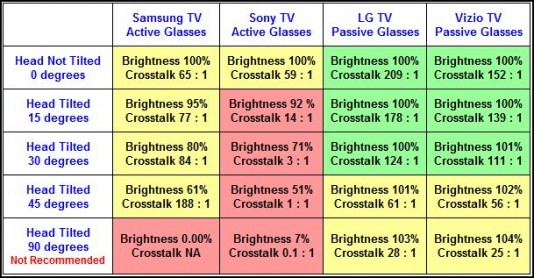Video testing experts weigh in on active versus passive display. The end result is more than the sum of technical specs.
Based on data from DisplayMate
Taking the “active vs. passive” debate on head-first, the video testing experts at DisplayMate have published the results of their Active vs. Passive 3D Glasses Shoot-Out. The study finds that passive 3DTVs, which use an alternating raster scan approach, deliver a full-HD resolution 3D experience due to image fusion in human visual perception. The findings are significant as it elevates the impact of human perception of image quality as a measure of the 3D experience, as specs alone seem inadequate.

DisplayMate examined four recent model high-end 3D LCD HDTVs—two with Active Shutter Glasses from Samsung and Sony, and two with FPR (Film-type Patterned Retarder) Passive Glasses from LG and Vizio. They were set up in a Shoot-Out configuration for detailed, simultaneous side-by-side comparisons. In a conciliatory note, DisplayMate adds, both of these competing 3D technologies each have their own set of particular strengths and weaknesses.
Sharpness and resolution with passive glasses
By far the most controversial and misunderstood issue in 3D TV currently has to do with the sharpness and resolution delivered with Passive Glasses. Because they split the odd and even lines between the right and left eyes it’s easy to see why many people (and some reviewers) conclude that FPR technology delivers only half of the HD resolution. Although unsubstantiated it still seems to have evolved into some sort of myth based on hearsay instead of actual scientific visual evaluation.
Many people seem to get stuck on this particular issue and can’t get beyond it and think about what is really being seen in actual 3D vision. But it’s not that simple because we watch TV from a far enough distance that the lines are not resolved and we know that the brain combines the images from both eyes into a single 3D image (the one we actually see) in a process called Image Fusion. The 3D TV images have only horizontal parallax from the horizontally offset cameras, so the vertical image content for the right and left eyes are in fact identical—but with purely horizontal parallax offsets from their different right and left camera viewpoints. So there isn’t any 3D imaging information that is missing because all of the necessary vertical resolution and parallax information is available when the brain combines the right and left images into the 3D image we actually see. That is the theory and fundamental principle behind 3D Image Fusion for FPR TVs—so DisplayMate tested it to see how accurate it is and how sharp the 3D images actually appear.

Sharpness and resolution with Active Shutter glasses
Active Shutter glasses also have 3D image sharpness issues, but they instead arise from left-right image crosstalk that can blur fine detail and muffle the 3D image depth and 3D Contrast. This results from the limited Response Time of the LCD screen and the LCD shutters on the Active Glasses. So both 3D technologies have 3D Image Sharpness issues—so both were tested to see how well they actually do.
The four TVs were set up side-by-side in a shoot-out configuration for detailed visual comparisons and measurements. All were simultaneously fed identical 1920 x 1080 x 24p frame-packed digital signal content using a Kramer Electronics 3D HDMI Distributor connected to a 3D Blu-ray player for movies and a PC with an Nvidia 3D graphics board and Nvidia 3DTV Play software to deliver our set of DisplayMate 3D test patterns, test photos and images.
The TVs were all 46-47 inch recent high-end models carefully selected for comparable performance and purchased new through retailers. Three of the units are LED Backlight 240 Hz Refresh Rate TVs that are close in price. The fourth unit was a much less expensive Vizio CCFL Fluorescent Backlight 120 Hz Refresh Rate FPR model that delivered impressive performance for its price.
Main conclusions
Based on DisplayMate’s lab measurements and visual test comparisons between 3D TVs with FPR Passive glasses versus 3D TVs with Active Shutter glasses, they found the Passive glasses TVs delivered substantially and demonstrably better all-around 3D imaging, 3D Contrast and sense of 3D depth, better 3D sharpness, better overall 3D picture quality, immersion and realism, and freedom from 3D ghosting, image crosstalk, and flicker. This was true in all but a small number of situations, all of which they document on the DisplayMate site.





